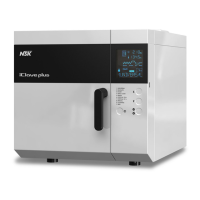18
4.5 TOPPING UP AND DRAINING THE WASTE WATER TANK
The sterilizer is fitted with two 4-liters tanks; main tank for the fresh demineralized water and recovery tank for
the waste water .
The hydraulic system does not reuse the condensate obtained during the sterilization process; this conden-
sate is collected in the waste water tank which must be periodically drained (except when used in combina-
tion with the water supply system Purity). This mode of operation involves the progressive emptying of the
main tank and the filling of the waste water tank.
4.5.1 Topping up the main tank
The average water consumption per sterilization cycle is 520 cc, hence 6 cycles can be performed with a full
tank (depends of the cycle selection)
The icon of the fresh water reservoir (main tank) blinks when it is full, when the maximum level is reached,
seven acoustic signals are released when the maximum is reached the first time (it will happen again only af-
ter one cycle or if the unit is switched off), then the icon will blink again with the empty symbol when there is
not enough water to run another cycle (the current cycle will be anyway completed).
Provide the topping up of the main tank, taking care not to exceed the maximum reference level marked by
the white float (level sensor) in the upper part of the tank. The blinking of the full drop icon and an acoustic
warning signals that the tank is full.
4.5.2 Draining the waste water tank
The lighting of the waste water reservoir icon rela-
tive to the waste water tank warns that the maxi-
mum level has been reached. In this case :
Get a bucket or a tank of at least 4 l capacity,
Fix the supply drain tube into the upper fast fitting (black),
Wait for a complete draining,
Unfit the tube pushing the button on the connector and drawing the tube.
CAUTION! The water contained in the waste water tank is to be regard-
ed as biologically contaminating, therefore when this tank is
emptied, suitable precautions should be taken. The disposal
of recovery water needs to be done in accordance with the
national or local regulation.

